ACCT7104 Case Study: Analysis of ONYA Ltd Acquisition of Remit
VerifiedAdded on 2022/12/30
|15
|2775
|77
Case Study
AI Summary
This case study analyzes the acquisition of Remit Pty Ltd by ONYA Ltd, focusing on the financial and accounting implications of the transaction. It examines the calculation of goodwill, the treatment of intangible assets (customer relationships, commercialized software, and brand name), and the preparation of consolidated financial statements. The analysis references relevant accounting standards issued by the AASB, specifically AASB 3 and AASB 138, to ensure proper accounting for the acquisition. The case study provides a detailed breakdown of the acquisition analysis, including the identification of identifiable assets and liabilities, and the subsequent impact on ONYA Ltd's financial position. It also offers recommendations for a smooth implementation of the acquisition process, considering the significant premium paid over Remit's net asset value. The study concludes with a report to the CFO and addresses the valuation of goodwill and intangible assets. The case study also emphasizes the importance of disclosures to ensure the reliability of financial information.

Running head: CORPORATE ACCOUNTING
Corporate Accounting
Name of the Student
Name of the University
Author Note
Corporate Accounting
Name of the Student
Name of the University
Author Note
Paraphrase This Document
Need a fresh take? Get an instant paraphrase of this document with our AI Paraphraser

1CORPORATE ACCOUNTING
Abstract
This document contains an analysis of the acquisition of Remit Pty by the ONYA group. It
includes the calculation of the amount of goodwill arising from the acquisition and the treatment
of the intangible assets arising from the same. This is done with reference to the relevant
accounting standards issued by the AASB and also by referring to various sources of literature.
The knowledge acquired is used in knowing the impact of the acquisition on the acquiring
company. A consolidated financial statement of the company after acquisition is prepared to
make the users understand the impact of the acquisition on the company. It ends with providing a
set of recommendations to be followed by the company in implementing the acquisition process
in a smooth manner.
Abstract
This document contains an analysis of the acquisition of Remit Pty by the ONYA group. It
includes the calculation of the amount of goodwill arising from the acquisition and the treatment
of the intangible assets arising from the same. This is done with reference to the relevant
accounting standards issued by the AASB and also by referring to various sources of literature.
The knowledge acquired is used in knowing the impact of the acquisition on the acquiring
company. A consolidated financial statement of the company after acquisition is prepared to
make the users understand the impact of the acquisition on the company. It ends with providing a
set of recommendations to be followed by the company in implementing the acquisition process
in a smooth manner.
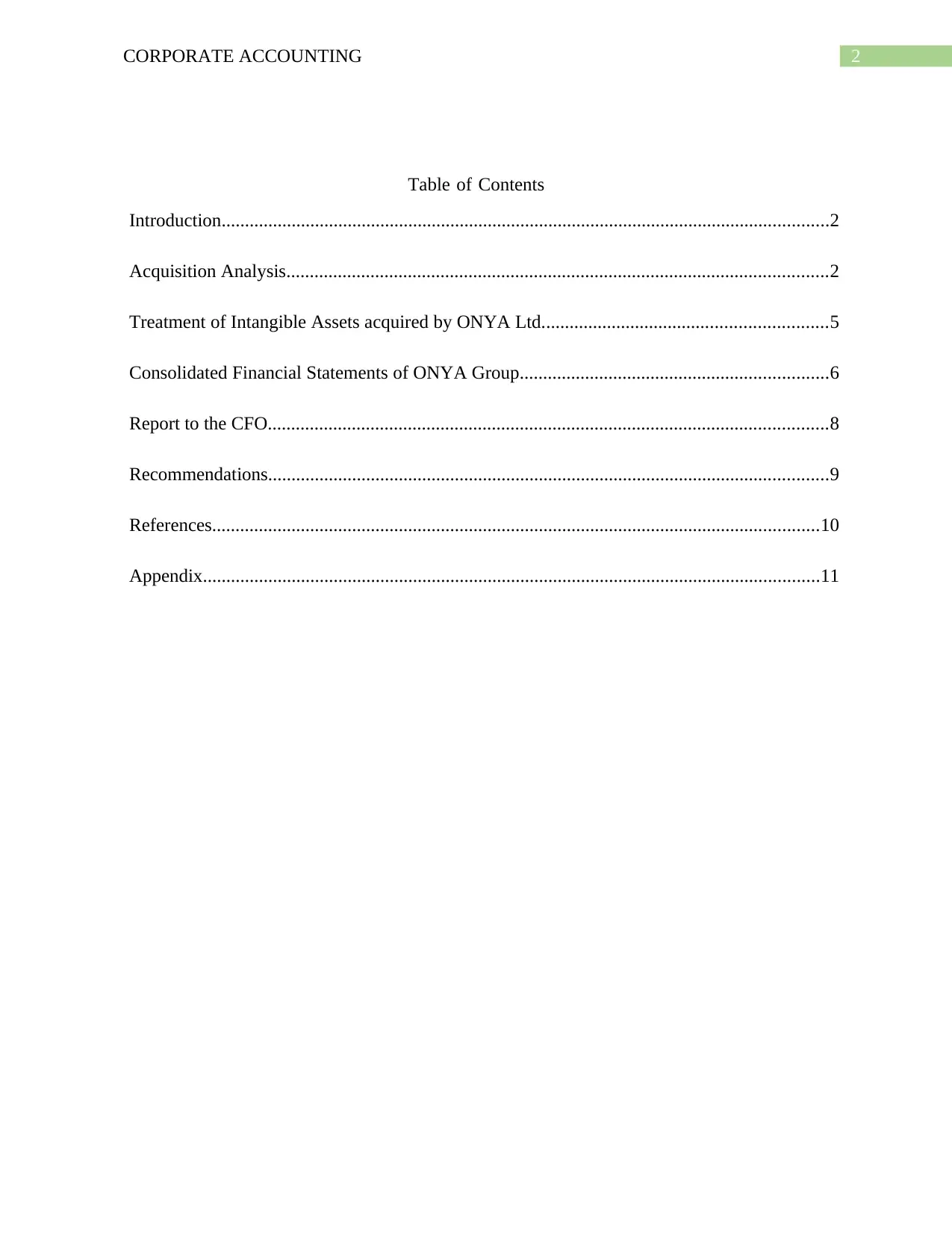
2CORPORATE ACCOUNTING
Table of Contents
Introduction..................................................................................................................................2
Acquisition Analysis....................................................................................................................2
Treatment of Intangible Assets acquired by ONYA Ltd.............................................................5
Consolidated Financial Statements of ONYA Group..................................................................6
Report to the CFO........................................................................................................................8
Recommendations........................................................................................................................9
References..................................................................................................................................10
Appendix....................................................................................................................................11
Table of Contents
Introduction..................................................................................................................................2
Acquisition Analysis....................................................................................................................2
Treatment of Intangible Assets acquired by ONYA Ltd.............................................................5
Consolidated Financial Statements of ONYA Group..................................................................6
Report to the CFO........................................................................................................................8
Recommendations........................................................................................................................9
References..................................................................................................................................10
Appendix....................................................................................................................................11
⊘ This is a preview!⊘
Do you want full access?
Subscribe today to unlock all pages.

Trusted by 1+ million students worldwide
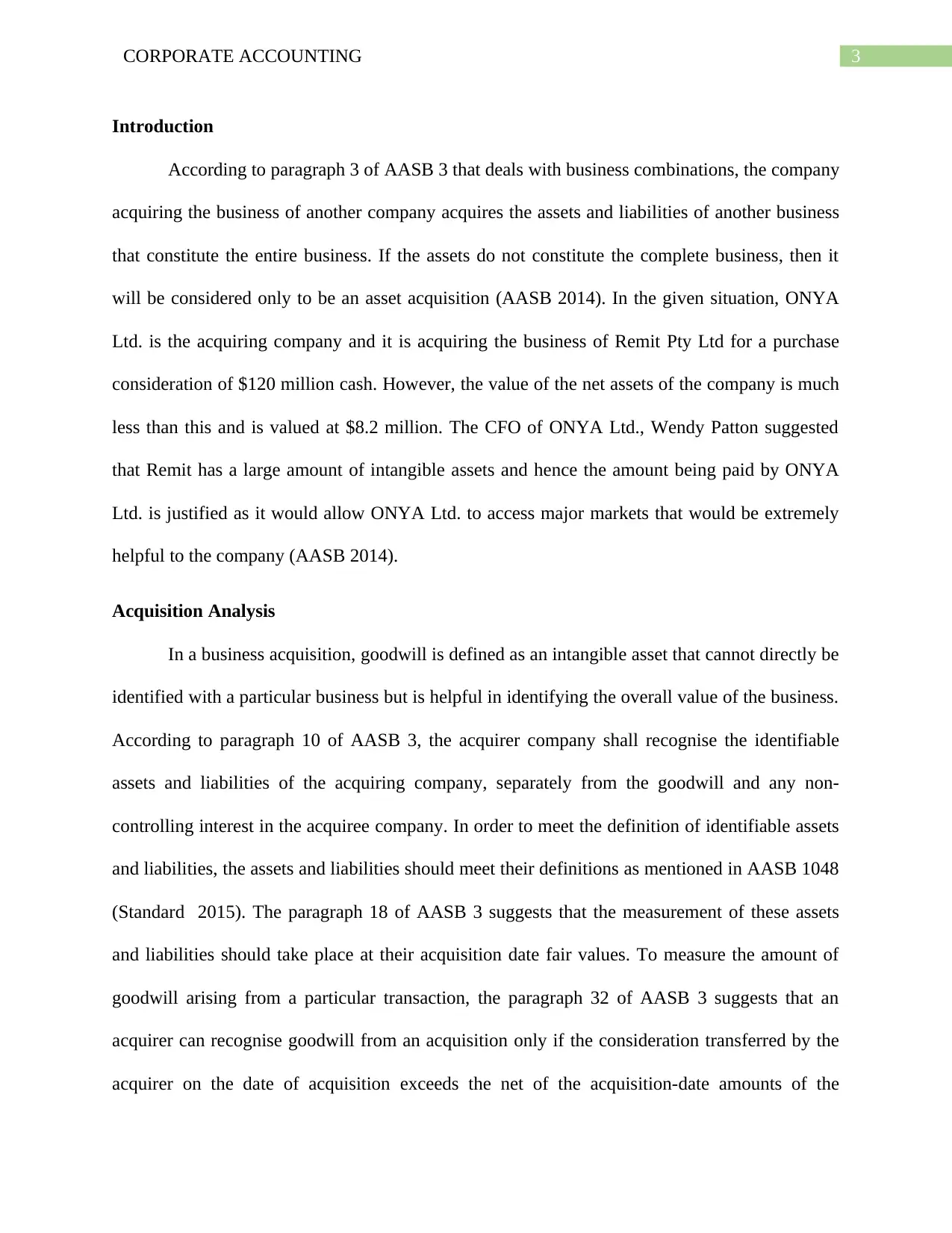
3CORPORATE ACCOUNTING
Introduction
According to paragraph 3 of AASB 3 that deals with business combinations, the company
acquiring the business of another company acquires the assets and liabilities of another business
that constitute the entire business. If the assets do not constitute the complete business, then it
will be considered only to be an asset acquisition (AASB 2014). In the given situation, ONYA
Ltd. is the acquiring company and it is acquiring the business of Remit Pty Ltd for a purchase
consideration of $120 million cash. However, the value of the net assets of the company is much
less than this and is valued at $8.2 million. The CFO of ONYA Ltd., Wendy Patton suggested
that Remit has a large amount of intangible assets and hence the amount being paid by ONYA
Ltd. is justified as it would allow ONYA Ltd. to access major markets that would be extremely
helpful to the company (AASB 2014).
Acquisition Analysis
In a business acquisition, goodwill is defined as an intangible asset that cannot directly be
identified with a particular business but is helpful in identifying the overall value of the business.
According to paragraph 10 of AASB 3, the acquirer company shall recognise the identifiable
assets and liabilities of the acquiring company, separately from the goodwill and any non-
controlling interest in the acquiree company. In order to meet the definition of identifiable assets
and liabilities, the assets and liabilities should meet their definitions as mentioned in AASB 1048
(Standard 2015). The paragraph 18 of AASB 3 suggests that the measurement of these assets
and liabilities should take place at their acquisition date fair values. To measure the amount of
goodwill arising from a particular transaction, the paragraph 32 of AASB 3 suggests that an
acquirer can recognise goodwill from an acquisition only if the consideration transferred by the
acquirer on the date of acquisition exceeds the net of the acquisition-date amounts of the
Introduction
According to paragraph 3 of AASB 3 that deals with business combinations, the company
acquiring the business of another company acquires the assets and liabilities of another business
that constitute the entire business. If the assets do not constitute the complete business, then it
will be considered only to be an asset acquisition (AASB 2014). In the given situation, ONYA
Ltd. is the acquiring company and it is acquiring the business of Remit Pty Ltd for a purchase
consideration of $120 million cash. However, the value of the net assets of the company is much
less than this and is valued at $8.2 million. The CFO of ONYA Ltd., Wendy Patton suggested
that Remit has a large amount of intangible assets and hence the amount being paid by ONYA
Ltd. is justified as it would allow ONYA Ltd. to access major markets that would be extremely
helpful to the company (AASB 2014).
Acquisition Analysis
In a business acquisition, goodwill is defined as an intangible asset that cannot directly be
identified with a particular business but is helpful in identifying the overall value of the business.
According to paragraph 10 of AASB 3, the acquirer company shall recognise the identifiable
assets and liabilities of the acquiring company, separately from the goodwill and any non-
controlling interest in the acquiree company. In order to meet the definition of identifiable assets
and liabilities, the assets and liabilities should meet their definitions as mentioned in AASB 1048
(Standard 2015). The paragraph 18 of AASB 3 suggests that the measurement of these assets
and liabilities should take place at their acquisition date fair values. To measure the amount of
goodwill arising from a particular transaction, the paragraph 32 of AASB 3 suggests that an
acquirer can recognise goodwill from an acquisition only if the consideration transferred by the
acquirer on the date of acquisition exceeds the net of the acquisition-date amounts of the
Paraphrase This Document
Need a fresh take? Get an instant paraphrase of this document with our AI Paraphraser
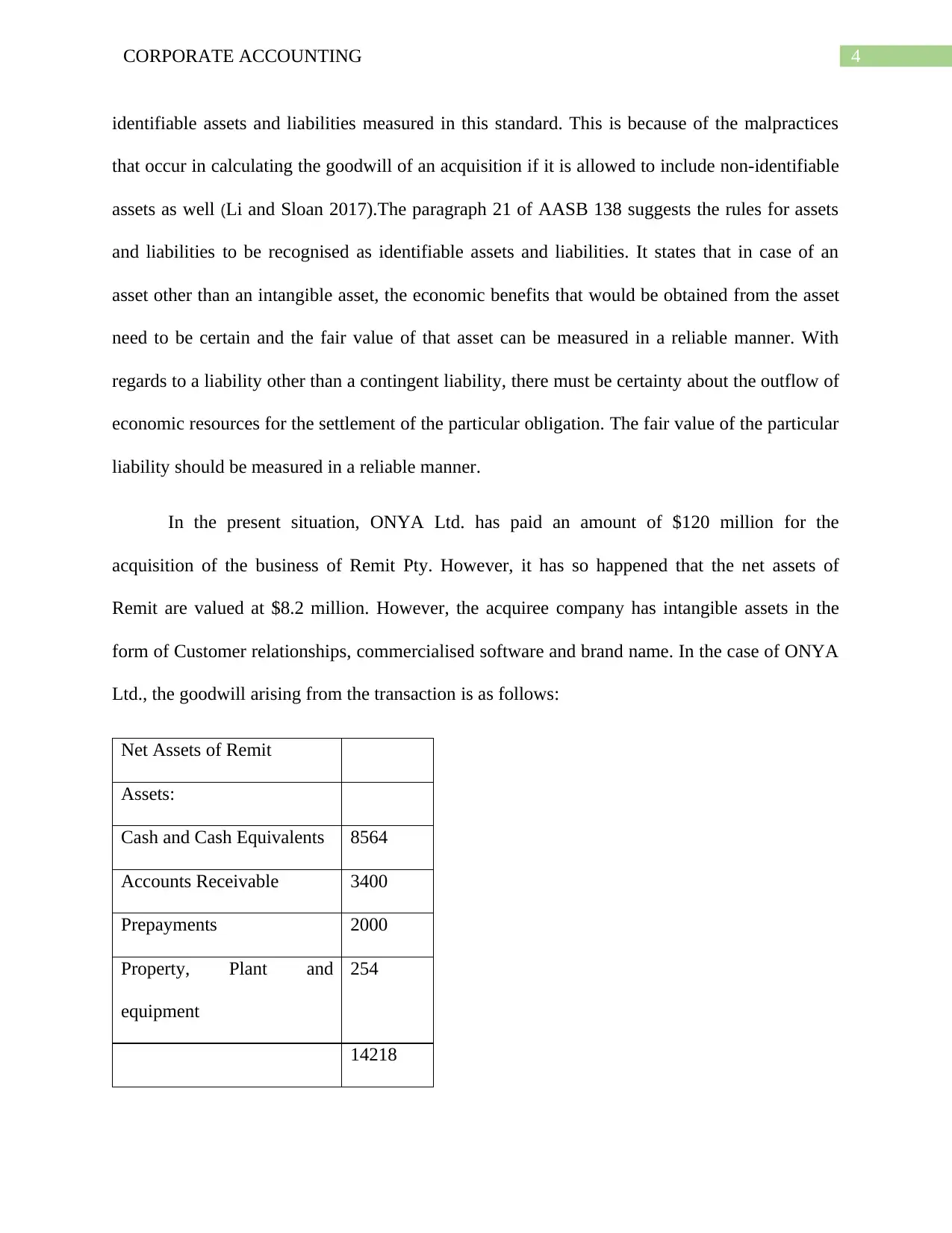
4CORPORATE ACCOUNTING
identifiable assets and liabilities measured in this standard. This is because of the malpractices
that occur in calculating the goodwill of an acquisition if it is allowed to include non-identifiable
assets as well (Li and Sloan 2017).The paragraph 21 of AASB 138 suggests the rules for assets
and liabilities to be recognised as identifiable assets and liabilities. It states that in case of an
asset other than an intangible asset, the economic benefits that would be obtained from the asset
need to be certain and the fair value of that asset can be measured in a reliable manner. With
regards to a liability other than a contingent liability, there must be certainty about the outflow of
economic resources for the settlement of the particular obligation. The fair value of the particular
liability should be measured in a reliable manner.
In the present situation, ONYA Ltd. has paid an amount of $120 million for the
acquisition of the business of Remit Pty. However, it has so happened that the net assets of
Remit are valued at $8.2 million. However, the acquiree company has intangible assets in the
form of Customer relationships, commercialised software and brand name. In the case of ONYA
Ltd., the goodwill arising from the transaction is as follows:
Net Assets of Remit
Assets:
Cash and Cash Equivalents 8564
Accounts Receivable 3400
Prepayments 2000
Property, Plant and
equipment
254
14218
identifiable assets and liabilities measured in this standard. This is because of the malpractices
that occur in calculating the goodwill of an acquisition if it is allowed to include non-identifiable
assets as well (Li and Sloan 2017).The paragraph 21 of AASB 138 suggests the rules for assets
and liabilities to be recognised as identifiable assets and liabilities. It states that in case of an
asset other than an intangible asset, the economic benefits that would be obtained from the asset
need to be certain and the fair value of that asset can be measured in a reliable manner. With
regards to a liability other than a contingent liability, there must be certainty about the outflow of
economic resources for the settlement of the particular obligation. The fair value of the particular
liability should be measured in a reliable manner.
In the present situation, ONYA Ltd. has paid an amount of $120 million for the
acquisition of the business of Remit Pty. However, it has so happened that the net assets of
Remit are valued at $8.2 million. However, the acquiree company has intangible assets in the
form of Customer relationships, commercialised software and brand name. In the case of ONYA
Ltd., the goodwill arising from the transaction is as follows:
Net Assets of Remit
Assets:
Cash and Cash Equivalents 8564
Accounts Receivable 3400
Prepayments 2000
Property, Plant and
equipment
254
14218
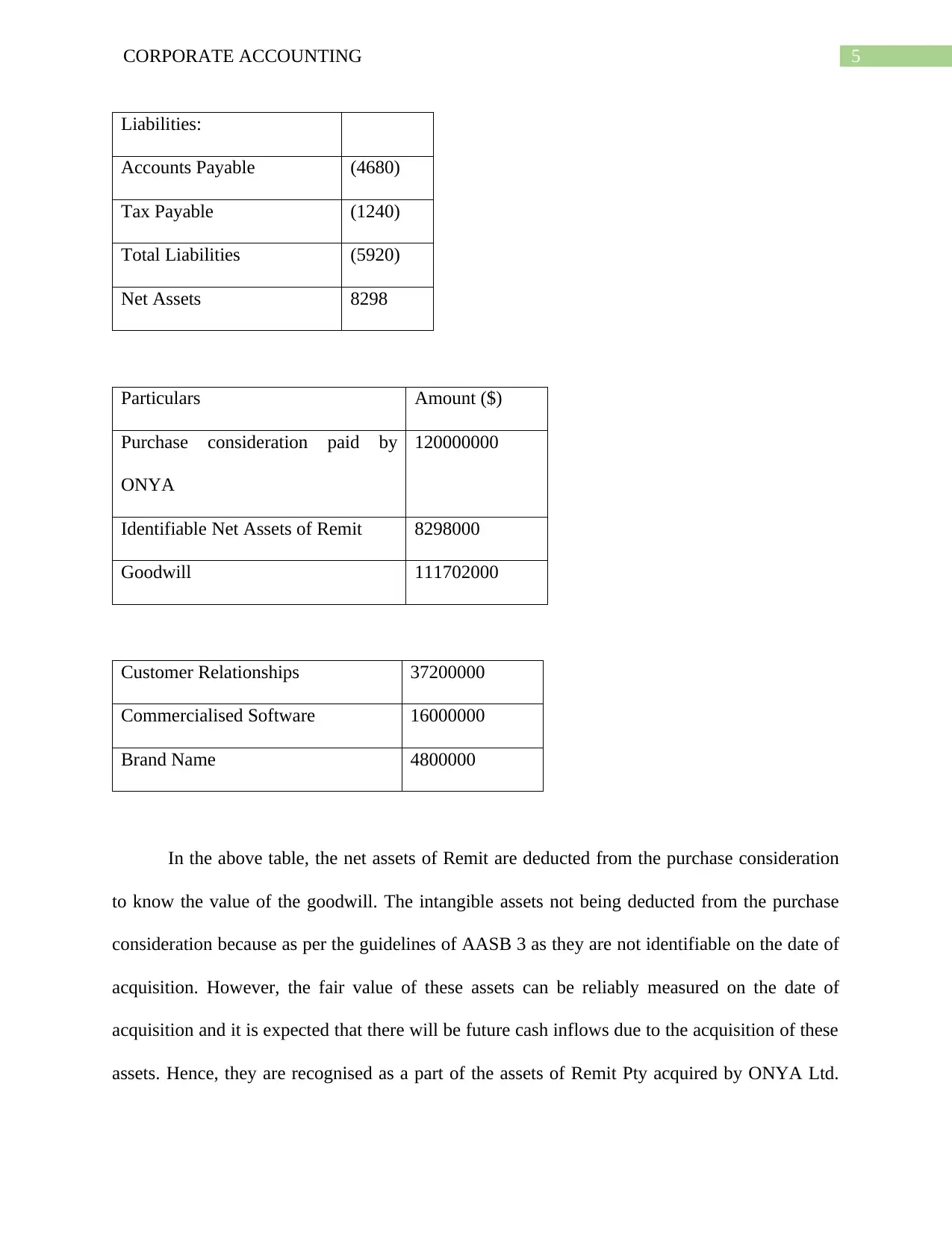
5CORPORATE ACCOUNTING
Liabilities:
Accounts Payable (4680)
Tax Payable (1240)
Total Liabilities (5920)
Net Assets 8298
Particulars Amount ($)
Purchase consideration paid by
ONYA
120000000
Identifiable Net Assets of Remit 8298000
Goodwill 111702000
Customer Relationships 37200000
Commercialised Software 16000000
Brand Name 4800000
In the above table, the net assets of Remit are deducted from the purchase consideration
to know the value of the goodwill. The intangible assets not being deducted from the purchase
consideration because as per the guidelines of AASB 3 as they are not identifiable on the date of
acquisition. However, the fair value of these assets can be reliably measured on the date of
acquisition and it is expected that there will be future cash inflows due to the acquisition of these
assets. Hence, they are recognised as a part of the assets of Remit Pty acquired by ONYA Ltd.
Liabilities:
Accounts Payable (4680)
Tax Payable (1240)
Total Liabilities (5920)
Net Assets 8298
Particulars Amount ($)
Purchase consideration paid by
ONYA
120000000
Identifiable Net Assets of Remit 8298000
Goodwill 111702000
Customer Relationships 37200000
Commercialised Software 16000000
Brand Name 4800000
In the above table, the net assets of Remit are deducted from the purchase consideration
to know the value of the goodwill. The intangible assets not being deducted from the purchase
consideration because as per the guidelines of AASB 3 as they are not identifiable on the date of
acquisition. However, the fair value of these assets can be reliably measured on the date of
acquisition and it is expected that there will be future cash inflows due to the acquisition of these
assets. Hence, they are recognised as a part of the assets of Remit Pty acquired by ONYA Ltd.
⊘ This is a preview!⊘
Do you want full access?
Subscribe today to unlock all pages.

Trusted by 1+ million students worldwide

6CORPORATE ACCOUNTING
Hence, the goodwill arising from the acquisition of the business is valued at $1117020000. The
total intangible assets of Remit Pty excluding the goodwill are arrived at $58000000.
Treatment of Intangible Assets acquired by ONYA Ltd.
As per the guidelines of AASB 3, if an intangible asset is acquired as a part of a business
combination then the assets are to be recognised at their fair value on the date of acquisition in
the books of accounts. This is also treated as the cost of the assets. This fair value is an indicator
of the acquirer’s expectations about the future economic benefits that will be received from the
acquisition of these assets. This standard also suggests that an acquiree shall recognise an
intangible asset arising from a business combination without considering whether these assets
were recognised at the time of acquiring the business or not. The AASB 112 suggests that the
income tax liability existing in the books of the acquiree becomes the tax liability of the
acquiring company (AASB 2013). In case of subsequent treatment of the intangible assets, there
are two methods that are allowed by AASB 138. They are the cost method and the revaluation
method. As per paragraph 74 of AASB 138, after recognising these particular intangible assets,
they are carried forward in the future books of accounts at cost less any accumulated
depreciation or amortisation or impairment losses arising on these particular assets. As stated in
paragraph 75 of AASB 138, the revaluation model is another method of recognising the value of
the intangible assets. This model suggests that after the process of initial recognition, an asset
shall be carried forward at any revalued amount, which is the fair value of the assets less
amortisation expenses, accumulated depreciation and subsequent impairment losses (Hu, Percy
and Yao 2015). In this case, fair value of an asset is measured by referring to the value of an
asset in an active market. However, the revaluations made in the value of the asset shall be done
on a regular basis so that the revalued amount does not significantly differ from the fair value of
Hence, the goodwill arising from the acquisition of the business is valued at $1117020000. The
total intangible assets of Remit Pty excluding the goodwill are arrived at $58000000.
Treatment of Intangible Assets acquired by ONYA Ltd.
As per the guidelines of AASB 3, if an intangible asset is acquired as a part of a business
combination then the assets are to be recognised at their fair value on the date of acquisition in
the books of accounts. This is also treated as the cost of the assets. This fair value is an indicator
of the acquirer’s expectations about the future economic benefits that will be received from the
acquisition of these assets. This standard also suggests that an acquiree shall recognise an
intangible asset arising from a business combination without considering whether these assets
were recognised at the time of acquiring the business or not. The AASB 112 suggests that the
income tax liability existing in the books of the acquiree becomes the tax liability of the
acquiring company (AASB 2013). In case of subsequent treatment of the intangible assets, there
are two methods that are allowed by AASB 138. They are the cost method and the revaluation
method. As per paragraph 74 of AASB 138, after recognising these particular intangible assets,
they are carried forward in the future books of accounts at cost less any accumulated
depreciation or amortisation or impairment losses arising on these particular assets. As stated in
paragraph 75 of AASB 138, the revaluation model is another method of recognising the value of
the intangible assets. This model suggests that after the process of initial recognition, an asset
shall be carried forward at any revalued amount, which is the fair value of the assets less
amortisation expenses, accumulated depreciation and subsequent impairment losses (Hu, Percy
and Yao 2015). In this case, fair value of an asset is measured by referring to the value of an
asset in an active market. However, the revaluations made in the value of the asset shall be done
on a regular basis so that the revalued amount does not significantly differ from the fair value of
Paraphrase This Document
Need a fresh take? Get an instant paraphrase of this document with our AI Paraphraser
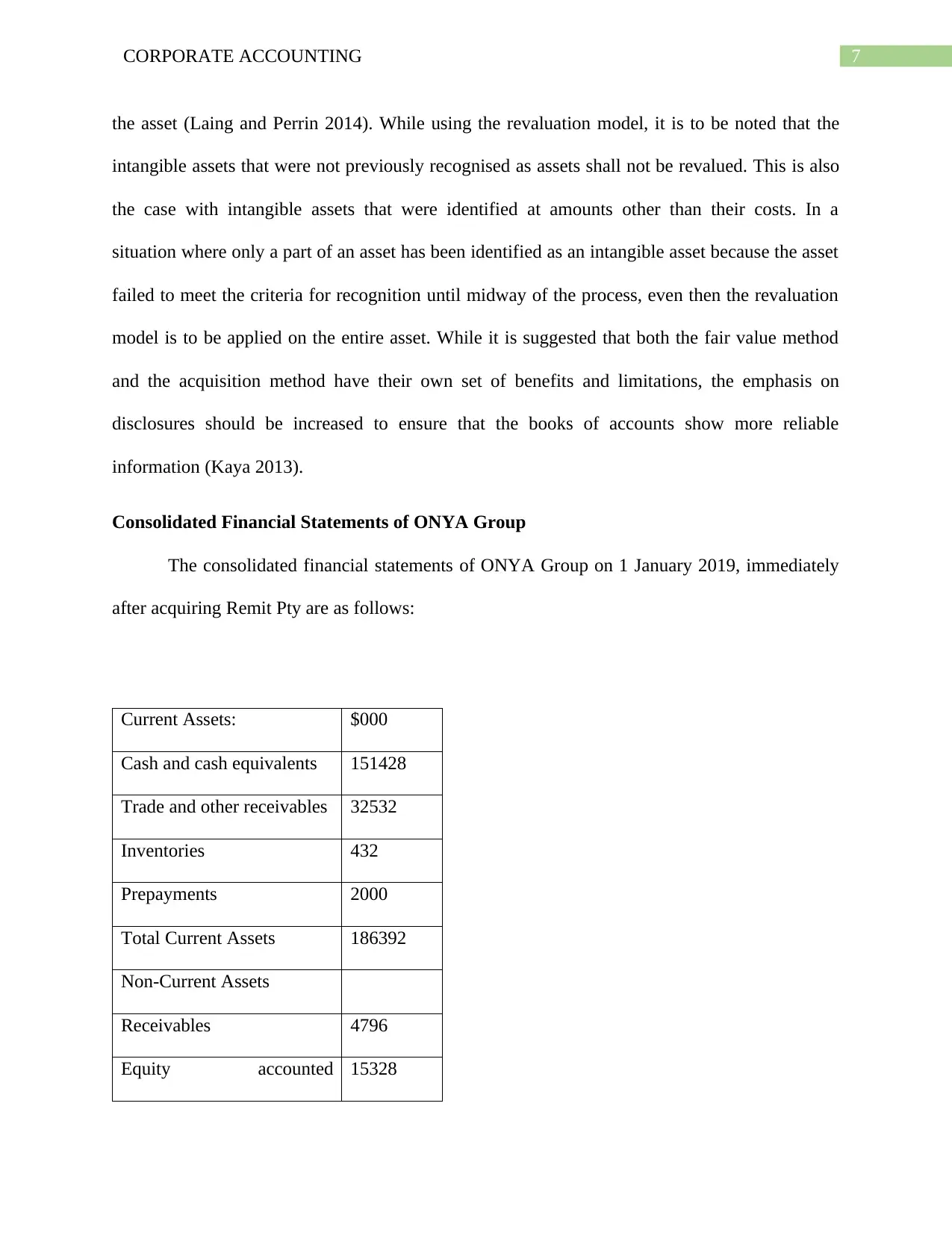
7CORPORATE ACCOUNTING
the asset (Laing and Perrin 2014). While using the revaluation model, it is to be noted that the
intangible assets that were not previously recognised as assets shall not be revalued. This is also
the case with intangible assets that were identified at amounts other than their costs. In a
situation where only a part of an asset has been identified as an intangible asset because the asset
failed to meet the criteria for recognition until midway of the process, even then the revaluation
model is to be applied on the entire asset. While it is suggested that both the fair value method
and the acquisition method have their own set of benefits and limitations, the emphasis on
disclosures should be increased to ensure that the books of accounts show more reliable
information (Kaya 2013).
Consolidated Financial Statements of ONYA Group
The consolidated financial statements of ONYA Group on 1 January 2019, immediately
after acquiring Remit Pty are as follows:
Current Assets: $000
Cash and cash equivalents 151428
Trade and other receivables 32532
Inventories 432
Prepayments 2000
Total Current Assets 186392
Non-Current Assets
Receivables 4796
Equity accounted 15328
the asset (Laing and Perrin 2014). While using the revaluation model, it is to be noted that the
intangible assets that were not previously recognised as assets shall not be revalued. This is also
the case with intangible assets that were identified at amounts other than their costs. In a
situation where only a part of an asset has been identified as an intangible asset because the asset
failed to meet the criteria for recognition until midway of the process, even then the revaluation
model is to be applied on the entire asset. While it is suggested that both the fair value method
and the acquisition method have their own set of benefits and limitations, the emphasis on
disclosures should be increased to ensure that the books of accounts show more reliable
information (Kaya 2013).
Consolidated Financial Statements of ONYA Group
The consolidated financial statements of ONYA Group on 1 January 2019, immediately
after acquiring Remit Pty are as follows:
Current Assets: $000
Cash and cash equivalents 151428
Trade and other receivables 32532
Inventories 432
Prepayments 2000
Total Current Assets 186392
Non-Current Assets
Receivables 4796
Equity accounted 15328
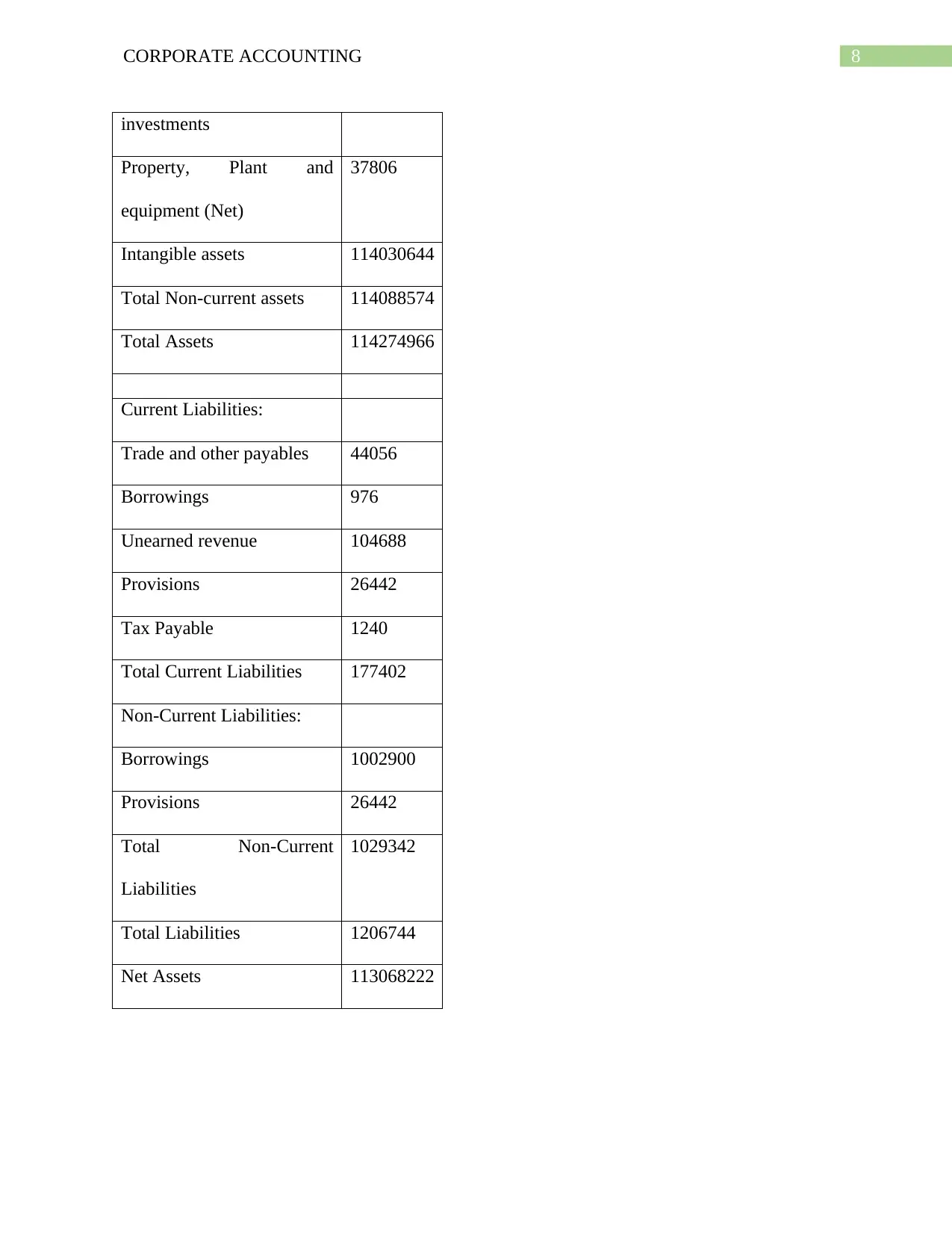
8CORPORATE ACCOUNTING
investments
Property, Plant and
equipment (Net)
37806
Intangible assets 114030644
Total Non-current assets 114088574
Total Assets 114274966
Current Liabilities:
Trade and other payables 44056
Borrowings 976
Unearned revenue 104688
Provisions 26442
Tax Payable 1240
Total Current Liabilities 177402
Non-Current Liabilities:
Borrowings 1002900
Provisions 26442
Total Non-Current
Liabilities
1029342
Total Liabilities 1206744
Net Assets 113068222
investments
Property, Plant and
equipment (Net)
37806
Intangible assets 114030644
Total Non-current assets 114088574
Total Assets 114274966
Current Liabilities:
Trade and other payables 44056
Borrowings 976
Unearned revenue 104688
Provisions 26442
Tax Payable 1240
Total Current Liabilities 177402
Non-Current Liabilities:
Borrowings 1002900
Provisions 26442
Total Non-Current
Liabilities
1029342
Total Liabilities 1206744
Net Assets 113068222
⊘ This is a preview!⊘
Do you want full access?
Subscribe today to unlock all pages.

Trusted by 1+ million students worldwide

9CORPORATE ACCOUNTING
Report to the CFO
It has been identified that mergers and acquisitions when done appropriately have a
positive impact on the companies undertaking them (Stiebale 2016). From the analysis of the
acquisition of Remit Pty by ONYA Ltd., it can be suggested that the acquisition is an extremely
costly procedure for ONYA Ltd. This is because even though the value of the net assets of the
company is only $8.2 million, the company is paying an amount of $120 million for acquiring
the same. This is over $112 million on the value of the assets of the company. Even if the
intangible assets worth $58 million are taken into consideration, the company is still paying an
additional amount of $54 million over the net assets of the company. This is because of the
value created by the investment made in acquiring the company (Kliestik et al. 2018). Due to this
acquisition by ONYA Ltd., the total current assets of the company have gone up by $13964000.
There has been an increase in the non-current assets by $254000. The intangible assets in the
form of customer relationships, commercialised software and brand name of Remit have together
contributed an amount of $58000000 to the intangible assets of the company. This also enables
the company to use the expertise and customer base of Remit for its own benefit. The amount of
goodwill other than these intangible assets has been paid by the company as it is expected that
the acquisition will be beneficial to the company. The current liabilities of the company will go
up by $5920000 while the non-current or long term liabilities of the company will remain
unchanged. There will be an increase in the overall net asset value of the company. Due to this
acquisition, the company does not suffer from any additional obligations in the long run.
However, it will have to meet the short term liabilities and will have to find the required cash to
do the same.
Report to the CFO
It has been identified that mergers and acquisitions when done appropriately have a
positive impact on the companies undertaking them (Stiebale 2016). From the analysis of the
acquisition of Remit Pty by ONYA Ltd., it can be suggested that the acquisition is an extremely
costly procedure for ONYA Ltd. This is because even though the value of the net assets of the
company is only $8.2 million, the company is paying an amount of $120 million for acquiring
the same. This is over $112 million on the value of the assets of the company. Even if the
intangible assets worth $58 million are taken into consideration, the company is still paying an
additional amount of $54 million over the net assets of the company. This is because of the
value created by the investment made in acquiring the company (Kliestik et al. 2018). Due to this
acquisition by ONYA Ltd., the total current assets of the company have gone up by $13964000.
There has been an increase in the non-current assets by $254000. The intangible assets in the
form of customer relationships, commercialised software and brand name of Remit have together
contributed an amount of $58000000 to the intangible assets of the company. This also enables
the company to use the expertise and customer base of Remit for its own benefit. The amount of
goodwill other than these intangible assets has been paid by the company as it is expected that
the acquisition will be beneficial to the company. The current liabilities of the company will go
up by $5920000 while the non-current or long term liabilities of the company will remain
unchanged. There will be an increase in the overall net asset value of the company. Due to this
acquisition, the company does not suffer from any additional obligations in the long run.
However, it will have to meet the short term liabilities and will have to find the required cash to
do the same.
Paraphrase This Document
Need a fresh take? Get an instant paraphrase of this document with our AI Paraphraser
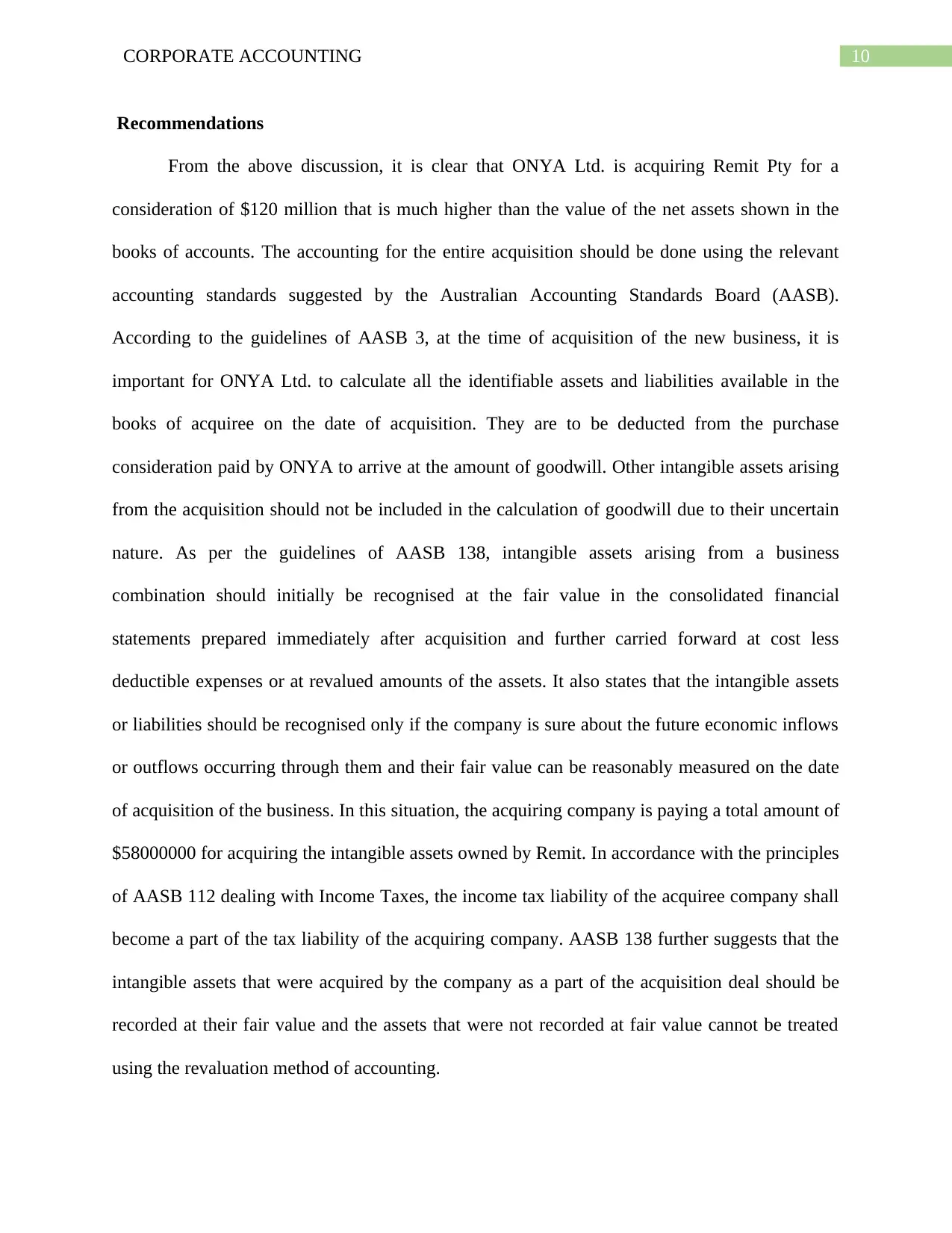
10CORPORATE ACCOUNTING
Recommendations
From the above discussion, it is clear that ONYA Ltd. is acquiring Remit Pty for a
consideration of $120 million that is much higher than the value of the net assets shown in the
books of accounts. The accounting for the entire acquisition should be done using the relevant
accounting standards suggested by the Australian Accounting Standards Board (AASB).
According to the guidelines of AASB 3, at the time of acquisition of the new business, it is
important for ONYA Ltd. to calculate all the identifiable assets and liabilities available in the
books of acquiree on the date of acquisition. They are to be deducted from the purchase
consideration paid by ONYA to arrive at the amount of goodwill. Other intangible assets arising
from the acquisition should not be included in the calculation of goodwill due to their uncertain
nature. As per the guidelines of AASB 138, intangible assets arising from a business
combination should initially be recognised at the fair value in the consolidated financial
statements prepared immediately after acquisition and further carried forward at cost less
deductible expenses or at revalued amounts of the assets. It also states that the intangible assets
or liabilities should be recognised only if the company is sure about the future economic inflows
or outflows occurring through them and their fair value can be reasonably measured on the date
of acquisition of the business. In this situation, the acquiring company is paying a total amount of
$58000000 for acquiring the intangible assets owned by Remit. In accordance with the principles
of AASB 112 dealing with Income Taxes, the income tax liability of the acquiree company shall
become a part of the tax liability of the acquiring company. AASB 138 further suggests that the
intangible assets that were acquired by the company as a part of the acquisition deal should be
recorded at their fair value and the assets that were not recorded at fair value cannot be treated
using the revaluation method of accounting.
Recommendations
From the above discussion, it is clear that ONYA Ltd. is acquiring Remit Pty for a
consideration of $120 million that is much higher than the value of the net assets shown in the
books of accounts. The accounting for the entire acquisition should be done using the relevant
accounting standards suggested by the Australian Accounting Standards Board (AASB).
According to the guidelines of AASB 3, at the time of acquisition of the new business, it is
important for ONYA Ltd. to calculate all the identifiable assets and liabilities available in the
books of acquiree on the date of acquisition. They are to be deducted from the purchase
consideration paid by ONYA to arrive at the amount of goodwill. Other intangible assets arising
from the acquisition should not be included in the calculation of goodwill due to their uncertain
nature. As per the guidelines of AASB 138, intangible assets arising from a business
combination should initially be recognised at the fair value in the consolidated financial
statements prepared immediately after acquisition and further carried forward at cost less
deductible expenses or at revalued amounts of the assets. It also states that the intangible assets
or liabilities should be recognised only if the company is sure about the future economic inflows
or outflows occurring through them and their fair value can be reasonably measured on the date
of acquisition of the business. In this situation, the acquiring company is paying a total amount of
$58000000 for acquiring the intangible assets owned by Remit. In accordance with the principles
of AASB 112 dealing with Income Taxes, the income tax liability of the acquiree company shall
become a part of the tax liability of the acquiring company. AASB 138 further suggests that the
intangible assets that were acquired by the company as a part of the acquisition deal should be
recorded at their fair value and the assets that were not recorded at fair value cannot be treated
using the revaluation method of accounting.
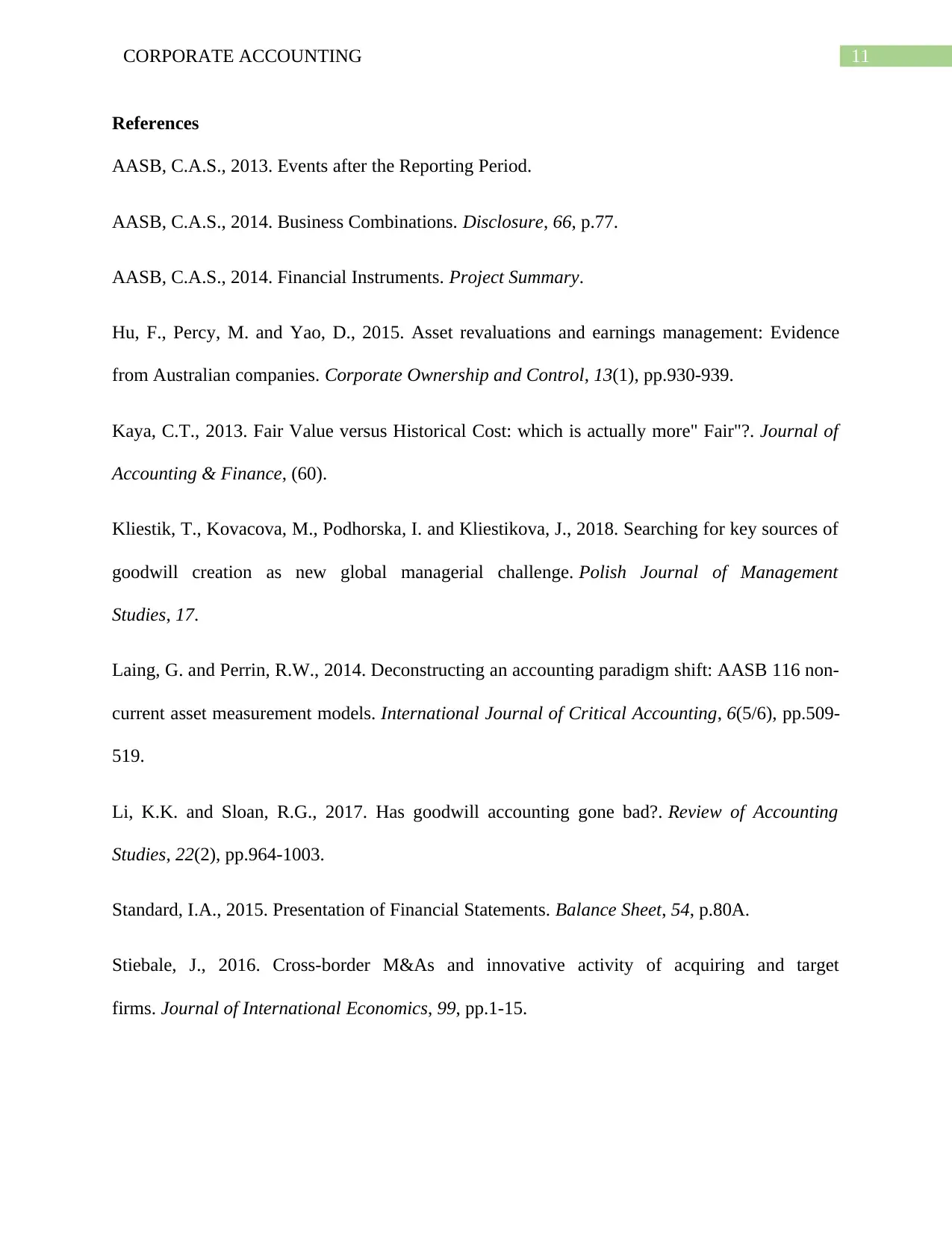
11CORPORATE ACCOUNTING
References
AASB, C.A.S., 2013. Events after the Reporting Period.
AASB, C.A.S., 2014. Business Combinations. Disclosure, 66, p.77.
AASB, C.A.S., 2014. Financial Instruments. Project Summary.
Hu, F., Percy, M. and Yao, D., 2015. Asset revaluations and earnings management: Evidence
from Australian companies. Corporate Ownership and Control, 13(1), pp.930-939.
Kaya, C.T., 2013. Fair Value versus Historical Cost: which is actually more" Fair"?. Journal of
Accounting & Finance, (60).
Kliestik, T., Kovacova, M., Podhorska, I. and Kliestikova, J., 2018. Searching for key sources of
goodwill creation as new global managerial challenge. Polish Journal of Management
Studies, 17.
Laing, G. and Perrin, R.W., 2014. Deconstructing an accounting paradigm shift: AASB 116 non-
current asset measurement models. International Journal of Critical Accounting, 6(5/6), pp.509-
519.
Li, K.K. and Sloan, R.G., 2017. Has goodwill accounting gone bad?. Review of Accounting
Studies, 22(2), pp.964-1003.
Standard, I.A., 2015. Presentation of Financial Statements. Balance Sheet, 54, p.80A.
Stiebale, J., 2016. Cross-border M&As and innovative activity of acquiring and target
firms. Journal of International Economics, 99, pp.1-15.
References
AASB, C.A.S., 2013. Events after the Reporting Period.
AASB, C.A.S., 2014. Business Combinations. Disclosure, 66, p.77.
AASB, C.A.S., 2014. Financial Instruments. Project Summary.
Hu, F., Percy, M. and Yao, D., 2015. Asset revaluations and earnings management: Evidence
from Australian companies. Corporate Ownership and Control, 13(1), pp.930-939.
Kaya, C.T., 2013. Fair Value versus Historical Cost: which is actually more" Fair"?. Journal of
Accounting & Finance, (60).
Kliestik, T., Kovacova, M., Podhorska, I. and Kliestikova, J., 2018. Searching for key sources of
goodwill creation as new global managerial challenge. Polish Journal of Management
Studies, 17.
Laing, G. and Perrin, R.W., 2014. Deconstructing an accounting paradigm shift: AASB 116 non-
current asset measurement models. International Journal of Critical Accounting, 6(5/6), pp.509-
519.
Li, K.K. and Sloan, R.G., 2017. Has goodwill accounting gone bad?. Review of Accounting
Studies, 22(2), pp.964-1003.
Standard, I.A., 2015. Presentation of Financial Statements. Balance Sheet, 54, p.80A.
Stiebale, J., 2016. Cross-border M&As and innovative activity of acquiring and target
firms. Journal of International Economics, 99, pp.1-15.
⊘ This is a preview!⊘
Do you want full access?
Subscribe today to unlock all pages.

Trusted by 1+ million students worldwide
1 out of 15
Related Documents
Your All-in-One AI-Powered Toolkit for Academic Success.
+13062052269
info@desklib.com
Available 24*7 on WhatsApp / Email
![[object Object]](/_next/static/media/star-bottom.7253800d.svg)
Unlock your academic potential
Copyright © 2020–2025 A2Z Services. All Rights Reserved. Developed and managed by ZUCOL.




